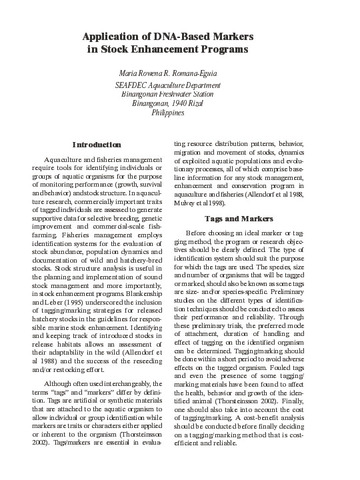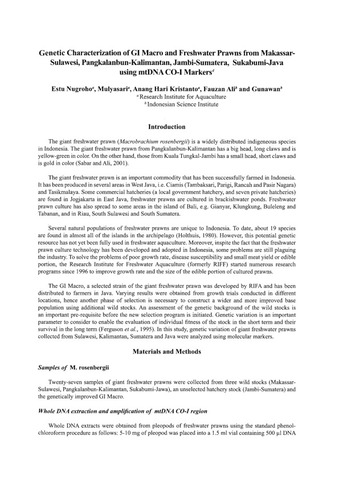Genetic diversity in farmed Asian Nile and red hybrid tilapia stocks evaluated from microsatellite and mitochondrial DNA analysis
- Global styles
- MLA
- Vancouver
- Elsevier - Harvard
- APA
- Help

View/
Date
2004Page views
1,554ASFA keyword
AGROVOC keyword
Metadata
Perlihat publikasi penuhCited times in Scopus
Share
Abstract
We analyzed microsatellite and mitochondrial DNA restriction fragment length polymorphism (mtDNA-RFLP) in two domesticated (NIFI and Israel) and four genetically improved (GIFT, GMT, FAC-selected and SEAFDEC-selected) Nile tilapia (Oreochromis niloticus) as well as five red hybrid tilapia (Oreochromis mossambicus × O. niloticus) stocks (BFS, FACred, NIFIred, HL, and PF) farmed in Asia. Microsatellite variation at five loci (UNH216, UNH172, UNH123, UNH147, UNH222) was more informative in characterizing stock differences than the mtDNA-RFLP markers that were based only on 14 restriction morphs. Contemporary microsatellite data showed that GIFT Nile tilapia had the highest mean expected heterozygosity (H>e=0.813), while GMT had the lowest (He=0.666). The unselected NIFI stock and SEAFDEC-selected were genetically similar, while GMT differed significantly from the other Nile tilapia stocks. Among the red tilapias, NIFIred had the highest He (0.715), while BFS had the lowest variability (He=0.567). The Taiwanese red tilapia HL and Thai NIFIred were genetically similar. Except for NIFI, most of the Nile and red tilapia stocks exhibited remarkably significant homozygote excess relative to Hardy–Weinberg Equilibrium (HWE), suggesting some degree of inbreeding. Asian Nile tilapias were more genetically diverse (pooled He=0.791; mtDNA nucleotide divergence value dA=0.009) than the red tilapias (pooled He=0.697; mean dA=0.004). This slight divergence between the Nile and red tilapias was also seen in the analysis of molecular variance (AMOVA; FCT=0.0018) and in genetic distance and nucleotide divergence dendrograms. However, the AMOVA revealed that the greater percentage of variation (99.33%) in the total genetic diversity of the surveyed stocks is principally due to differences at the individual level and not between nor within groups. The significance of these results is that they reflect and lead to new inferences regarding the selective breeding and culture methods used in managing these farmed stocks.
Suggested Citation
Romana-Eguia, M. R. R., Ikeda, M., Basiao, Z. U., & Taniguchi, N. (2004). Genetic diversity in farmed Asian Nile and red hybrid tilapia stocks evaluated from microsatellite and mitochondrial DNA analysis. Aquaculture , 236(1-4), 131-150. https://doi.org/10.1016/j.aquaculture.2004.01.026
Type
ArticleISSN
0044-8486Koleksi
- Journal Articles [1229]
Related items
Showing items related by title, author, creator and subject.
-
Preliminary assessment of genetic variation in the Japanese endemic freshwater crab, Geothelphusa dehaani, based on mitochondrial DNA sequences
Huervana, Joana Joy ; Kano, Yuichi
; Kano, Yuichi  ; Ando, Daiki; Onikura, Norio
; Ando, Daiki; Onikura, Norio  ; Kurita, Yoshihisa (Pensoft Publishers, 2023-06-27)
Geothelphusa dehaani, a freshwater crab species endemic to Japan, has the largest distribution range amongst the 19 known species in the country. Due to its low dispersal capability and restricted habitat to freshwater, ...
; Kurita, Yoshihisa (Pensoft Publishers, 2023-06-27)
Geothelphusa dehaani, a freshwater crab species endemic to Japan, has the largest distribution range amongst the 19 known species in the country. Due to its low dispersal capability and restricted habitat to freshwater, ... -
Application of DNA-based markers in stock enhancement programs
Romana-Eguia, Maria Rowena R. (Aquaculture Department, Southeast Asian Fisheries Development Center, 2006)
Aquaculture and fisheries management require tools for identifying individuals or groups of aquatic organisms for the purpose of monitoring performance (growth, survival and behavior) and stock structure. In aquaculture ...
(Aquaculture Department, Southeast Asian Fisheries Development Center, 2006)
Aquaculture and fisheries management require tools for identifying individuals or groups of aquatic organisms for the purpose of monitoring performance (growth, survival and behavior) and stock structure. In aquaculture ... -
Genetic characterization of GI Macro and freshwater prawns from Makassar-Sulawesi, Pangkalanbun-Kalimantan, Jambi-Sumatera, Sukabumi-Java using mtDNA CO-I markers
Nugroho, Estu; Mulyasari; Kristanto, Anang Hari; Ali, Fauzan; Gunawan (Aquaculture Department, Southeast Asian Fisheries Development Center, 2007)The giant freshwater prawn (Macrobrachium rosenbergii) is a widely distributed indigenous species in Indonesia. The giant freshwater prawn from Pangkalanbun-Kalimantan has a big head, long claws and is yellow-green in ...




